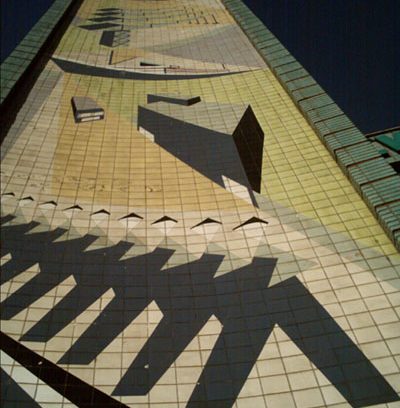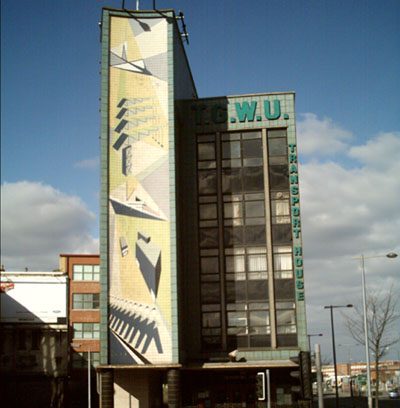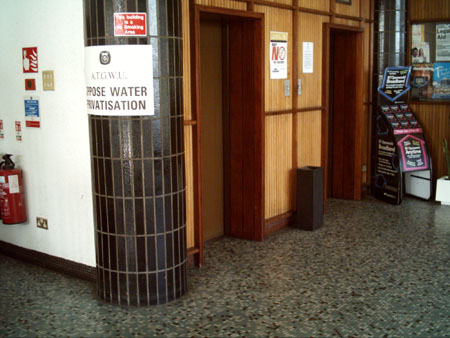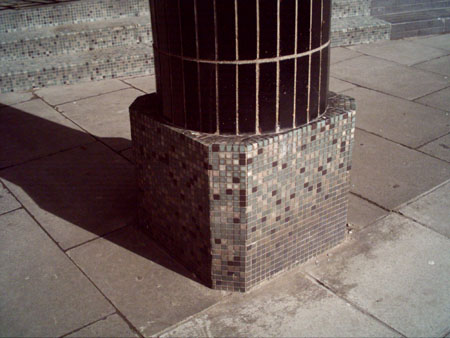This website uses cookies
This website uses cookies to enable it to function properly and to analyse how the website is used. Please click 'Close' to accept and continue using the website.






May 2005 - Transport House, Belfast
Text by Michael MacAmhalai
Transport House is the Belfast headquarters of the Amalgamated Transport and General Workers’ Union. Built in 1959, in the International Style, it has become the focal hub of the Province’s trade union movement, and one of Northern Ireland’s youngest listed buildings. Historic Buildings and Monuments, in its 1994 schedule, described Transport House as “…a very assertive building – dramatic in its impact, exhibiting a range of modernist features in a well worked out scheme…”
The architect, J. J. Brennan, was undoubtedly inspired by Michael Scott’s successful International Style Áras Mhic Dhiarmada – better known as Busáras; the Dublin bus terminal and administrative offices of Coras Iompair Éireann (CIE). Busáras, described as “Ireland’s first contemporary structure of significance”, opened 9 October 1953 to international attention and acclaim, and Michael Scott was lauded in the press “for completing Dublin’s first contemporary office block before London had even started to build one”.
Transport House appears as two conjoined blocks; one, five stories in height, and the other, seven; clad, for the most part, in green glazed tiles; supported at each end by pilotis. The freestanding column shafts are wrapped in black glazed tiles and the bases have a mosaic finish. The building features raised lettering; a concrete canopy, cantilevered over the main entrance; and, most strikingly, a five-storey high tiled mural, set in a concave wall. The mural is reminiscent of the heroic iconography of the Soviet Constructivists (which was widely seen in London at the 1951 Festival of Britain) and depicts the industries of Northern Ireland; a plane, cranes, a ship, and a factory, and, at its base, the united proletariat – a phalanx of uniformed workers – without whom, all industry would grind to a halt.
The International Style building has tremendous nostalgic value; it is evocative of Sputnik, Castro, extra-soapy ‘Rinso’, Elvis and Eisenhower. The building contrasts with the stolid expressions of weight and mass that defines Belfast’s predominantly Victorian architecture. One of the city’s best known landmarks, the empire-inspired, Victorian Albert Clock, grave and authoritative, just across the street from Transport House, leans away from the progressive trade union building; the architecture of each, more pronounced by the juxtaposition; their stylistic elements, more conspicuous – as is the concomitant clash of ideologies.
In 1959, as AT&GWU staff unpacked their boxes, the latest craze from America was being manufactured in Britain – a Hula Hoop could be bought for only 6s 6d; Harold Macmillan was telling the electorate ‘You have never had it so good’; and the film I’m All Right, Jack, with Peter Sellers, was released. The film, parodying trade union readiness to ‘down tools’, signalled the emergent public perception that there was an existent ‘strike culture’. Transport House, built before the ensuing Thatcher years, at trade unionism’s apogee, may be said to embody the salad days of the AT&GWU.
Look for past Buildings of the Month by entering the name of an individual building or architect or browsing the drop down list.

Become a C20 member today and help save our modern design heritage.